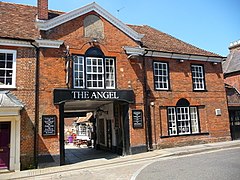The Angel Inn
 The Angel Inn
The Angel InnThe Angel Inn is a public house in Andover, Hampshire. Constructed in the mid-15th century, it is one of the oldest surviving inns in England, and the oldest and most complete example in Hampshire. It is a Grade II* listed building, of "more than special interest nationally." Despite alterations in the 16th, 17th, 18th and 19th centuries, the 15th century timber frame, features and decorative details remain "remarkably intact." Archaeological and documentary evidence suggest that it was built on the site of a previous inn—the College Inn—which was destroyed in the Great Fire of Andover in 1434.
Originally constructed of four wings enclosing a central courtyard, with an archway giving access from the street—typical of late medieval inns—the pub now retains the north and east wings. The west wing is no longer extant, while the surviving section of the south wing—which was divided from the inn for other commercial uses in the 18th century—is now also Grade II* listed (under the designation "89, 91 & 93 High Street, Andover.") The main bar room is situated in the ground floor of the north wing, which housed stables during the medieval period. The 'front bar' occupies the ground floor room—originally a high status guest chamber—at the eastern end of the north wing, looking onto the High Street. During the early 19th century, the front bar also served as the town's magistrates' court and guildhall.
In the 1960s, Andover became an overspill town for London, resulting in redevelopment of the town centre and the construction of a large shopping centre. The Angel Inn—along with other late medieval parts of the town—was initially earmarked for demolition in 1965 as part of the redevelopment, but was saved following a campaign by members of the public.
The Angel Inn is listed by CAMRA—the Campaign for Real Ale—as one of the best cask ale pubs in the UK.
Built between 1445–1455, the Angel Inn is the oldest surviving inn—and the oldest surviving building—in Andover. Local tradition claims that the site has housed an inn or tavern since at least 1174, and that a part of the fabric of the current building dates from this time. Although there is no documentary evidence for a 12th century inn, stone "robbed" from the nearby 12th century priory has been found re-used in a Tudor dwelling on the High Street. H.W. Earney, in his Inns of Andover (1971), notes: "Saxon Andover consisted of two main thoroughfares—the Harrow Way to London, and the road from Southampton to Newbury. These two roads once crossed in front of the Angel Inn, so that it is likely, when the first Andover inn was built, that this was the most convenient spot for it to be sited." Edward Roberts also states that such a "prime urban site" would have been a likely location for medieval hostelries. Certainly, beer was being retailed in Andover by 1317, as an entry in the Guild Rolls for that year records a decree that beer should be sold in the town for the price of 1½ d. per barrel.
...
Wikipedia